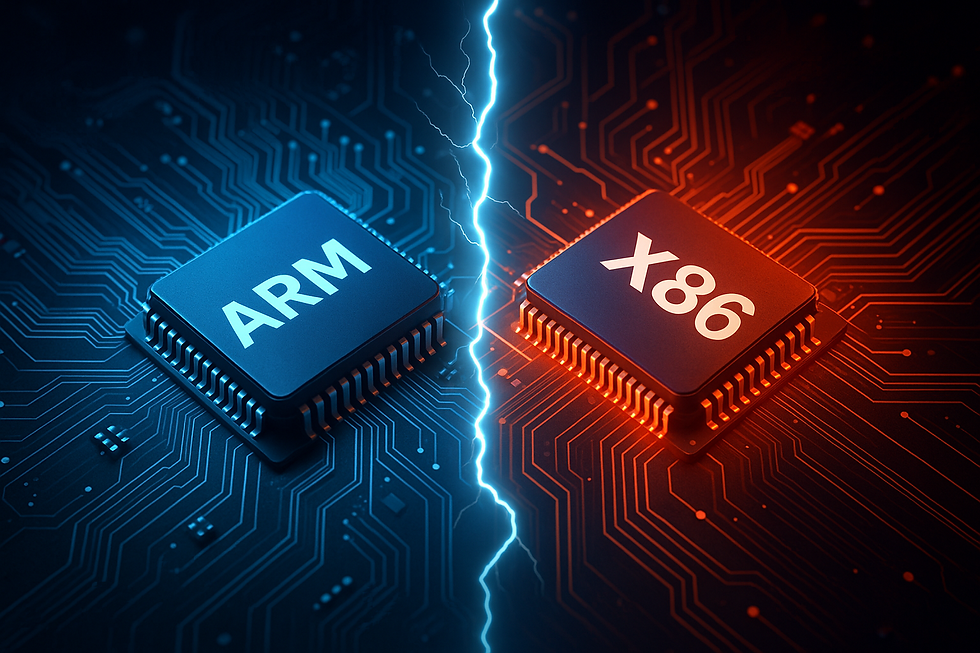ARM vs x86 for Embedded and IoT Hardware: How to Choose
- nellalin
- Aug 11
- 6 min read
Updated: Aug 24

Table of Contents:
What Are ARM and x86 Architectures?
Why Does Power Consumption Matter — and Why Does ARM Lead?
How Does Performance Differ Between ARM and x86?
What Is the Thermal Profile and Physical Size Impact?
How Do BOM and Licensing Affect Cost?
How Do Software Compatibility and Ecosystem Compare?
Which Ecosystem and Community Support Is Stronger?
How Do ARM and x86 Compare in Scalability and Product Roadmap?
What About Vendor Lock-in and Supply Chain Risks?
How Does the ARM vs x86 Summary Table Look?
Why Is Choosing ARM or x86 Not Just About Specs?
How Rightway Helps Startups Make the Right Architecture Choice
Choosing the right processor architecture is one of the most critical decisions in embedded and IoT hardware design. For startups, particularly those scaling from prototype to production, the debate often comes down to ARM vs x86 — two dominant processor architectures that differ significantly in design philosophy, performance profiles, cost structures, and ecosystem compatibility.
This article provides a comprehensive comparison of ARM and x86 processors for embedded systems and IoT hardware, helping hardware founders and engineers navigate this crucial decision. Whether you’re designing a smart home hub, industrial sensor network, or wearable device, the right choice can make or break your product’s scalability and cost-efficiency.
What Are ARM and x86 Architectures?
ARM (Advanced RISC Machine) is a Reduced Instruction Set Computing (RISC) architecture licensed by Arm Holdings. ARM cores power billions of devices globally, especially in mobile, IoT, and embedded systems.
x86 refers to the Complex Instruction Set Computing (CISC) architecture developed by Intel and AMD. It dominates in PCs, servers, and high-performance applications.
While both are widely used, their suitability depends heavily on the use case — especially in power-constrained, cost-sensitive, or space-limited embedded designs.
1. Why Does Power Consumption Matter — and Why Does ARM Lead?
For most IoT and embedded use cases, power efficiency is non-negotiable — especially in battery-powered devices.
ARM processors are designed for low power draw, thanks to their RISC architecture and aggressive power management features. ARM Cortex-M series MCUs can operate on microwatts, and Cortex-A series CPUs like those in the Raspberry Pi 5 balance performance with power.
x86 processors consume more power, especially legacy or desktop-grade CPUs. While Intel’s Atom and AMD’s embedded lines have improved, they still generally fall short of ARM’s efficiency.
🔍 Real-world insight: According to a 2023 EETimes analysis, ARM-based systems can deliver up to 4x better performance-per-watt compared to comparable x86 systems in low-power embedded contexts.
Verdict: ARM wins for power efficiency — crucial in mobile, wearable, or remote sensing environments.
2. How Does Performance Differ Between ARM and x86?
Performance isn’t just about clock speed — it’s about how well a system handles the specific workload of your device.
x86 CPUs generally offer higher single-threaded and multi-threaded performance, especially with modern Intel Core or AMD Ryzen Embedded chips. These are suited for edge AI, media processing, and applications that require local inference or high I/O throughput.
ARM's performance scales widely depending on core type. Cortex-A processors can handle Linux OS and multitasking, while Cortex-M processors are ideal for real-time low-power tasks.
🔍 Example: NVIDIA Jetson Nano (ARM Cortex-A57 + GPU) can run TensorFlow Lite models at the edge with ~5–10W power budget. An x86 system with equivalent AI inference power might require 15–25W.
Verdict: Choose ARM for lightweight, distributed computing; choose x86 for intensive edge workloads with local analytics or media needs.
3. What Is the Thermal Profile and Physical Size Impact?
ARM chips typically have lower heat output, enabling fanless operation and compact enclosures — ideal for wearables, smart sensors, and space-constrained designs.
x86 chips often require active cooling or larger heat sinks, especially in higher-performance categories.
This impacts industrial design and reliability — thermal throttling in x86-based designs can degrade long-term performance if not handled properly.
Verdict: ARM offers a more manageable thermal footprint, critical in enclosed or outdoor deployments.
4. How Do BOM and Licensing Affect Cost?
When it comes to Bill of Materials (BOM) cost, ARM often holds a clear advantage.
ARM’s licensing model enables a diverse range of chipmakers (e.g., NXP, STMicro, MediaTek, Rockchip) to offer competitive pricing.
x86 is vertically integrated, with limited vendor options (mostly Intel and AMD), leading to higher ASPs (average selling prices) and less negotiation flexibility.
Non-Recurring Engineering (NRE) costs also vary — ARM platforms often have more open-source toolchains and broader community support, reducing dev costs.
🔍 Case in point: A 2024 report by IC Insights noted that average embedded ARM SoCs are 30–50% cheaper than equivalent x86 counterparts at mid-scale volumes.
Verdict: ARM wins on cost — particularly important for startups watching margins.
5. How Do Software Compatibility and Ecosystem Compare?
This is a complex trade-off, and highly use-case dependent.
x86 architecture supports full Windows and many legacy x86 libraries, which can be crucial if your software stack includes commercial PC apps or drivers.
ARM excels in Linux-based embedded OS environments (e.g., Yocto, OpenWRT, Android Things) and is supported by most modern toolchains and SDKs.
🔍 Example: If your IoT product needs to run a lightweight Linux distro and custom firmware, ARM is typically better supported. However, if you need Windows 10 IoT Enterprise or commercial apps with no ARM support, x86 may be required.
Verdict: ARM is better suited for modern embedded Linux workflows, while x86 is better if Windows or legacy compatibility is required.
6. Which Ecosystem and Community Support Is Stronger?
ARM dominates the embedded world:
Vast number of open-source development boards (Raspberry Pi, BeagleBone, etc.)
Strong community and low barrier to prototyping
Long-standing use in microcontroller ecosystems (e.g., STM32, NXP i.MX)
x86 is more mature in the PC and server realm, but embedded board availability is limited compared to ARM SBCs.
🔍 Note: ARM-based dev boards can cost as little as $10–50 and are widely documented; comparable x86 boards can start at $150+.
Verdict: ARM has a larger, more accessible ecosystem for embedded developers.
7. How Do ARM and x86 Compare in Scalability and Product Roadmap?
Your processor choice today affects your ability to scale and maintain products tomorrow.
ARM's modular architecture (Cortex-M to Cortex-A to Cortex-R) allows startups to scale from MCU prototypes to full Linux-based edge devices — often with code reuse and consistent toolchains.
x86 lacks that kind of vertical scalability in embedded markets. If you start with a low-power Atom chip, jumping to Core or Xeon embedded versions may require board and software redesigns.
Additionally, many ARM vendors offer 10–15 years of lifecycle support, important for industrial or medical devices.
Verdict: ARM offers better scalability for startups planning product lines across performance tiers.
8. What About Vendor Lock-in and Supply Chain Risks?
With ARM, you can choose from dozens of chip vendors, which mitigates the risk of being tied to a single supplier or geopolitical region.
With x86, your vendor choices are effectively Intel or AMD, both of which have longer lead times and are more exposed to supply fluctuations, particularly in advanced nodes.
During COVID-era shortages, many ARM-based MCU suppliers were able to adapt by shifting between fabs or sourcing alternative SKUs — a flexibility x86 didn’t offer.
🔍 Case Study: A 2023 teardown of consumer smart displays (Counterpoint Research) showed that 75% used ARM-based SoCs from Rockchip, MediaTek, or Amlogic — largely due to supply diversity and cost flexibility.
Verdict: ARM offers more vendor flexibility and lower geopolitical risk.
Summary Table: ARM vs x86 for Embedded / IoT Products
Factor | ARM | x86 |
Power Efficiency | ✅ Excellent (ideal for low-power) | ❌ Higher power draw |
Performance | 🔁 Varies (good at edge, RT tasks) | ✅ Strong single-threaded & multitask |
Thermal Management | ✅ Low heat, fanless designs possible | ❌ Often requires active cooling |
BOM / Unit Cost | ✅ Lower cost, many vendors | ❌ Higher cost, limited vendors |
Software Compatibility | ✅ Linux, Android, FreeRTOS | ✅ Windows, legacy x86 |
Ecosystem / Dev Boards | ✅ Large (Pi, ST, NXP, etc.) | ❌ Limited for embedded |
Long-term Scalability | ✅ Cortex-M to Cortex-A progression | ❌ Limited in embedded progression |
Supply Chain Flexibility | ✅ Diverse fab and vendor ecosystem | ❌ Tied to Intel/AMD |
Why Is Choosing ARM or x86 Not Just About Specs?
While ARM is clearly dominant in many embedded and IoT contexts, there are valid reasons to choose x86 — particularly where Windows OS compatibility, high edge compute performance, or legacy systems are in play.
But for startups, especially those building low-power, connected devices for consumer, industrial, or medical use — ARM offers better flexibility, lower costs, and better supply chain resilience.
How Rightway Helps Startups Make the Right Architecture Choice
At Rightway, we help early-stage hardware teams evaluate processor architecture choices not just from a spec sheet — but from a product and manufacturing standpoint:
Architecture benchmarking and BOM cost modeling
Design-for-manufacturing (DFM) support around processor integration
Vendor matchmaking and risk analysis
Scalability planning — choosing an architecture that grows with your roadmap
We're based in Asia, embedded in the factory ecosystem — giving us unique insight into chip availability, sourcing risks, and real-world performance trade-offs. Whether you’re building a smart health device or next-gen industrial controller, we help bridge the gap between technical feasibility and scalable production.
📩 Want help deciding between ARM and x86 for your product? Reach out at www.rightway-tech.com




Comments